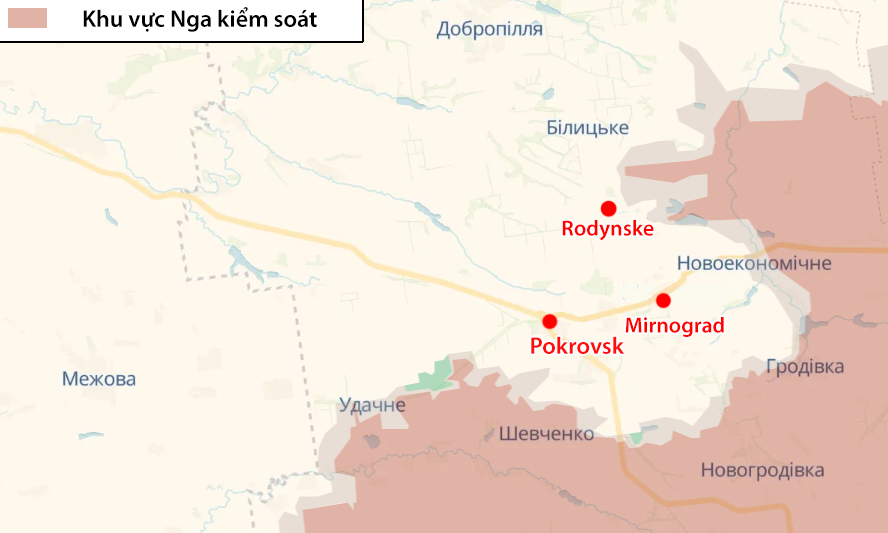DeepState, a Ukrainian defense ministry-linked analysis group, reported on 5/8 that Russian forces are concentrating their attacks on Rodynske, a city north of the Ukrainian-held stronghold of Pokrovsk and Mirnograd in Donetsk province. "Defensive units are making every effort to prevent the enemy's advance," the group stated.
A Ukrainian National Guard officer acknowledged the same day that Russia is expanding the "gray zone" – the contested area around Rodynske where neither side has full control.
A source close to Ukrainian military intelligence revealed that Russian first-person view (FPV) drones are constantly operating along the M-30 highway connecting Pokrovsk with Pavlograd, hindering Ukrainian logistical efforts in the area.
 |
Location of Pokrovsk and surrounding settlements. Graphics: DeepState |
Ukrainian military experts consider Rodynske a key location due to its role as a rear base for Pokrovsk and Mirnograd. Controlling this city would allow Russia to intensify its encirclement strategy and increase pressure on Ukrainian defenders at the Pokrovsk front, aiming to capture this strategic Ukrainian stronghold in Donetsk province.
Russian offensives over the past three months have formed a pincer movement around the Pokrovsk-Mirnograd front. This puts Ukrainian units at risk of being trapped in a "cauldron," a term often used by Russia to describe large-scale encirclements where they deploy substantial forces to surround an area on multiple sides, leaving only one escape route.
This tactic has been successfully employed in campaigns against fortified strongholds like Avdeevka, Ugledar, and Kurakhovo. The Pokrovsk operation differs with the inclusion of deep penetration special forces, creating dual pressure on Ukrainian defenders.
According to the German newspaper Bild, Russia's Pokrovsk offensive consists of three phases: isolating the combat zone, cutting off supply lines, and launching coordinated attacks from multiple directions.
The first phase began earlier this year with increased Russian attacks east of Pokrovsk, aiming to sever supply routes from the north and west. The UK Ministry of Defence estimates that Russia has deployed a large force, up to 160,000 troops, to exert pressure from the southeast, southwest, and north.
Heavy artillery and mechanized infantry are deployed in the southeast, coordinating frontal assaults to break through Ukraine's main defensive lines. Tank forces are responsible for the southwest, tasked with controlling strategic roads and railways.
Russian airborne and light mechanized units are concentrated in the north, blocking any Ukrainian reinforcement attempts.
This tactic allows the Russian military to maintain constant pressure without incurring heavy losses. "Russian forces are attempting to bypass Pokrovsk from the east to tighten the encirclement, rather than engaging in costly frontal assaults," said Viktor Trehubov, spokesperson for Ukrainian forces on the eastern front.
The next phase began when crucial supply routes from the Ukrainian rear to Pokrovsk, including the T-0406 and E-50 highways, came within range of Russian artillery and FPV drones. Numerous Ukrainian transport convoys have been attacked en route to and from Pokrovsk, leading to frequent resource shortages for the defending forces.
In addition to tightening the encirclement and disrupting supply lines, Russia has deployed special reconnaissance units to infiltrate the city center.
Ukrainska Pravda quoted soldiers stationed in Pokrovsk as saying they detected Russian special forces infiltrating the city since mid-July. A video posted by a Ukrainian soldier shows a Ukrainian military vehicle being ambushed by Russian troops at the intersection of Shevchenko and Zakhystnykiv Ukrayiny streets in the city center, resulting in at least one Ukrainian soldier being shot.
Ukrainian analysts believe these Russian special reconnaissance units plan to establish defensive positions and await reinforcements. "Sadly, we have suffered losses, and friendly fire incidents are increasing. Everyone knows that enemy reconnaissance groups have appeared, but few know their movements and locations," DeepState added.
These infiltration tactics not only exert psychological pressure on Ukrainian soldiers but also weaken their defensive coordination.
Alexander Khramchikhin, an expert at the Moscow-based Institute for Political and Military Analysis, believes the attacks on Pokrovsk's outskirts and infiltration activities within the city will cause "serious cracks" in Ukrainian defenses.
 |
Russian soldiers of the Central Military District in Donetsk province in July. Photo: RIA Novosti |
Ukrainian experts and soldiers compare the situation in Pokrovsk to Avdeevka and Ugledar, strategic strongholds that Ukrainian forces had to abandon after Russia established cauldrons. Ukrainian units attempted to hold these two cities for as long as possible, leading to difficult withdrawals under heavy Russian fire and significant casualties.
Ivan Stupak, a Ukrainian military expert, believes the Ukrainian army will likely have to leave Pokrovsk within 60 days. "The Russian army is gradually tightening the encirclement. The corridor in and out of Pokrovsk is about 17 km wide, and movement through it is still relatively safe. However, if the situation deteriorates, attempting to hold Pokrovsk will be impossible," he said.
Phong Lam (According to Bild, Topwar, Euromaidan Press, Vzglyad)












